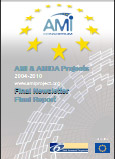Media Synchronisation
In order for media captured using the AMI Instrumented Meeting room to be synchronized, the following equipment has been included and integrated:
- 1 Horita BSG-50 PAL blackburst generator
- 1 Mark of the Unicorn MIDI Timepiece AV
- 7 Horita AVG-50 LTC-VITC translator
Horita BSG-50 PAL
The Horita BSG-50 PAL blackburst generator produces a composite video reference signal and outputs this signal on multiple outputs. Other items of video and synchronization equipment are then able to lock to this reference signal, therefore ensuring perfect synchronization across all system components. In the Smart Meeting Room, the BSG-50 acts as a master clock source, providing a common blackburst reference signal to each of the Sony cameras. The cameras are able to synchronize with the blackburst signal, resulting in all cameras sampling video frames at exactly the same instant. Another BSG-50 output is connected to the MOTU MIDI Timepiece AV, which locks to the blackburst reference signal and generates all other timing signals.
MOTU MIDI Timepiece AV
The MOTU MIDI Timepiece AV is a flexible synchronizer capable of slaving to and/or generating a variety of timing signals. In the Smart Meeting Room, the blackburst output from the Horita BSG-50 PAL is input to the MIDI Timepiece AV, which locks to the reference signal and then uses it to derive the following timing signals,
- Word clock. This is a square wave signal that is used to synchronize audio sampling across different equipment.
- Longitudinal Time Code (LTC). This is an industry standard hours-minutes-seconds-frames (HH:MM:SS:FF) timecode where the frame count (FF) corresponds to a video standard (eg. PAL=25fps). For each video frame, the complete timecode is encoded into an 80-bit word, resulting in an 2kHz signal that can be recorded and played-back like any other audio signal.
- MIDI Time Code (MTC). This is a timing signal used by MIDI equipment, and contains the same time code as for LTC.
In the Smart Meeting Room, the MIDI Timepiece AV generates a 48kHz Word Clock which is transmitted to the external clock input of each PreSonus Digimax. This ensures that all 24 input audio channels are sampled simultaneously. The LTC generated by the MIDI Timepiece AV is converted internally to MIDI Time Code (MTC) and transmitted via USB or via a Midi connector to the different PCs (video-slide-whiteboard PC, audio acquisition PC). The Cakewalk SONAR recording software on the audio acquisition PC is able to synchronize with the MTC and then accurately timestamp the acquired audio samples. The LTC is also output directly to each Horita AVG-50 LTC-VITC translator for insertion into each video camera signal. This is discussed in the following section.
Horita AVG-50
The Horita AVG-50 LTC-VITC Translator inserts a Vertical Interval Time Code (VITC) into an input video signal. The VITC can be internally generated, or can be derived from an incoming LTC signal. VITC is a television industry time code standard that encodes the same HH:MM:SS:FF information used in LTC into a 90-bit word. The 90-bit pattern is then inserted into the top few lines of each frame of video as a sequence of 90 black and white dots. Normally, the VITC is inserted in the vertical blanking region of a video frame (ie. not visible on normal television screens). However, because video recordering remove the vertical blanking region from a video signal prior to digitization, the AVG-50 can be configured to insert the VITC into the active region of each frame. The AVG-50 can also optionally insert a character version of the VITC at the bottom of each frame, which is useful when manually viewing and editing recorded video. In the Smart Meeting Room, the composite output of each camera is input to separate AVG-50’s along with the LTC generated by the MOTU MIDI Timepiece AV. Each AVG-50 converts the LTC to VITC and inserts it into the video frames. The composite outputs from the AVG-50’s (containing the VITC) are then fed to the composite inputs on the IEI IVC4300 video acquisition cards. The VITC is guaranteed to be perfectly synchronized with each frame of video, because the cameras and the LTC source (ie. the MIDI Timepiece AV) are genlocked to the common video reference signal output from the Horita BSG-50 PAL. The result of the VITC insertion is that each frame of video contains a timestamp that corresponds exactly to the timestamp that is used by Cakewalk SONAR and stored with the acquired audio. This timestamp can be easily interpreted in order to accurately realign any audio channel with any video channel.


